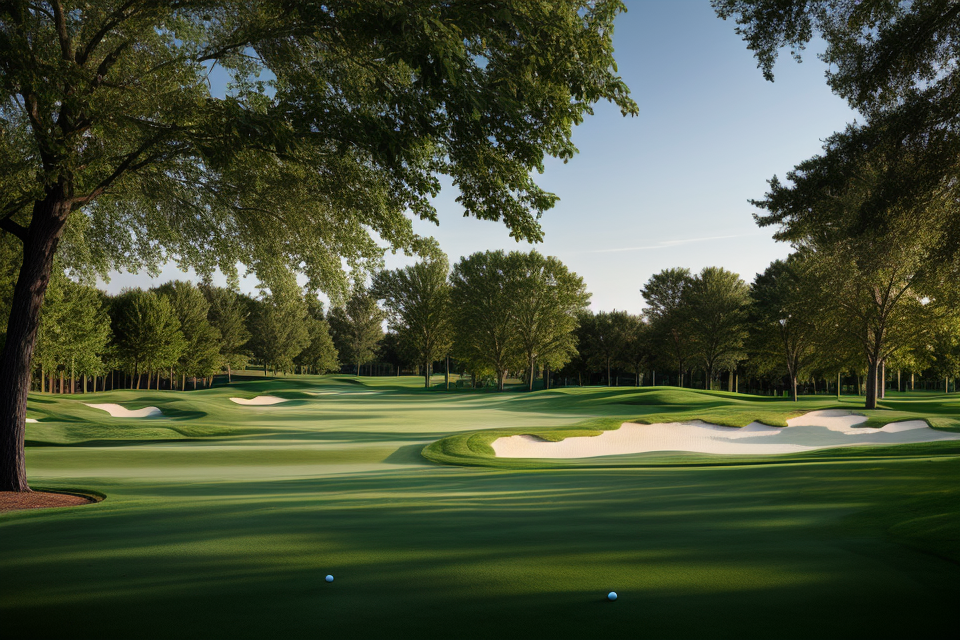Living on a golf course may seem like a dream come true for avid golfers and nature lovers alike. The picturesque views, the serene surroundings, and the exclusive access to a world-class golf course can be quite enticing. However, is it really all sunshine and rainbows? In this comprehensive guide, we will delve into the pros and cons of living on a golf course to help you make an informed decision. From the tranquility of the surroundings to the potential drawbacks of living in a golf course community, we’ll cover it all. So, let’s tee off and explore the ins and outs of this unique lifestyle.
Factors to Consider When Deciding to Live on a Golf Course
Privacy and Peacefulness
Living on a golf course offers a unique opportunity to enjoy a tranquil and serene environment. However, it is essential to consider the pros and cons of this lifestyle to determine whether it suits your preferences.
Pros of living on a golf course
- Spacious properties with ample greenery and open spaces
- Peaceful and quiet neighborhoods with minimal traffic
- Impressive views of the golf course and surrounding landscapes
- Close proximity to golf courses, which can be an attractive feature for golf enthusiasts
Cons of living on a golf course
- Limited access to public transportation, which may require a car for daily commutes
- Higher costs associated with property maintenance and upkeep, especially during peak golf season
- Potential for noise disturbances from golf course activities, especially early in the morning or late at night
- The exclusive nature of golf course communities may limit social interactions with a diverse range of people
It is important to weigh these factors carefully before deciding to live on a golf course, as they can significantly impact your quality of life and daily routine.
Access to Amenities
One of the key factors to consider when deciding to live on a golf course is the access to amenities. Here are some pros and cons to think about:
Pros of Living on a Golf Course
- World-Class Golfing Experience: Living on a golf course provides residents with easy access to a world-class golfing experience. They can enjoy playing golf on a well-maintained course, which is often designed by top golf course architects.
- Spectacular Views: Many golf courses are situated in picturesque locations, providing residents with breathtaking views of nature. The lush green fairways, the sparkling lakes, and the towering trees can make for a truly magnificent sight.
- High-End Amenities: Golf courses often come with high-end amenities such as clubhouses, restaurants, fitness centers, and swimming pools. These facilities are designed to provide residents with a luxurious lifestyle.
Cons of Living on a Golf Course
- High Cost of Living: Living on a golf course can be expensive. The cost of the homes is usually higher compared to other neighborhoods, and there may be additional fees for access to the golf course and its amenities.
- Limited Access to Other Amenities: Golf courses are often located in remote areas, which can limit the access to other amenities such as shopping centers, schools, and hospitals. Residents may need to travel a significant distance to access these facilities.
- Limited Social Diversity: Golf courses tend to attract a specific demographic, which can limit the social diversity of the community. This may not be desirable for those who enjoy a more diverse and inclusive social environment.
In conclusion, living on a golf course provides residents with access to world-class golfing experiences, spectacular views, and high-end amenities. However, it also comes with a high cost of living, limited access to other amenities, and limited social diversity. These pros and cons should be carefully considered when deciding to live on a golf course.
Environmental Impact
When considering living on a golf course, it is important to weigh the environmental impact of doing so. While there are benefits to the environment, there are also potential drawbacks.
Pros of Living on a Golf Course
- Green Spaces: Golf courses provide large expanses of green spaces that help to mitigate the urban heat island effect. These green spaces also provide habitat for wildlife and help to absorb stormwater runoff.
- Carbon Sequestration: The grasses on golf courses absorb carbon dioxide from the atmosphere, which helps to reduce the amount of greenhouse gases in the atmosphere.
- Aesthetic Appeal: Golf courses are often beautiful and visually appealing, which can enhance the quality of life for those living nearby.
Cons of Living on a Golf Course
- Water Usage: Golf courses require a significant amount of water to maintain their greens and fairways. This can be a concern in areas with water scarcity.
- Pesticide Use: Golf courses often use pesticides and herbicides to maintain their grounds, which can be harmful to the environment and to those living nearby.
- Habitat Fragmentation: Golf courses can fragment natural habitats, making it difficult for wildlife to move freely across the landscape.
In conclusion, living on a golf course has both pros and cons when it comes to environmental impact. While there are benefits to the environment, it is important to consider the potential drawbacks as well.
Cost of Living
Living on a golf course can come with additional expenses that should be considered before making the decision. The cost of living on a golf course includes various factors such as property prices, utility bills, maintenance costs, and other related expenses.
- Property values: Homes located on a golf course tend to have higher property values due to their unique location and the added amenities that come with living on a golf course.
- Access to golf courses: Living on a golf course provides easy access to golf courses, which can be a significant advantage for golf enthusiasts.
-
Security: Golf courses often have strict security measures in place, which can provide a sense of safety and security for residents.
-
Higher property prices: The cost of purchasing a home on a golf course can be significantly higher than in other areas.
- Additional expenses: Maintenance costs for the golf course, including green fees, can add up to a significant amount each year.
- Limited privacy: Golf courses are often open to the public, which can result in limited privacy for residents.
In conclusion, living on a golf course can be an excellent choice for those who love golf and are willing to pay for the added amenities and benefits. However, it is essential to consider the potential additional expenses that come with living on a golf course before making the decision.
Safety and Security
Living on a golf course can offer a sense of safety and security, but it also comes with its own set of risks. In this section, we will explore the pros and cons of living on a golf course in terms of safety and security.
Well-lit and Secure Environment
One of the biggest advantages of living on a golf course is the sense of security that comes with living in a well-lit and secure environment. Golf courses are typically well-lit at night, which can deter potential intruders and make residents feel safer. Additionally, many golf courses have security measures in place, such as gates and security guards, which can provide an added layer of protection.
Close-knit Community
Another advantage of living on a golf course is the close-knit community that often forms among residents. Living in a close-knit community can provide a sense of safety and security, as neighbors look out for one another and report any suspicious activity to the authorities.
Wildlife and Other Hazards
While living on a golf course can be safe and secure, it can also come with its own set of hazards. For example, wildlife such as snakes and alligators may be more prevalent on a golf course, which can pose a danger to residents. Additionally, golf courses may have hazards such as sand traps and water hazards, which can be dangerous for children and pets.
Golf Cart Accidents
Another potential hazard of living on a golf course is the risk of golf cart accidents. Golf carts are a common mode of transportation on golf courses, but they can also be dangerous if not operated properly. Residents who own golf carts must take care to follow safety guidelines and operate them responsibly to avoid accidents.
In conclusion, living on a golf course can offer a sense of safety and security, but it is important to consider both the pros and cons before making a decision. While there are many advantages to living in a well-lit and secure environment with a close-knit community, there are also potential hazards such as wildlife, golf cart accidents, and other hazards to consider. By weighing the pros and cons, residents can make an informed decision about whether living on a golf course is right for them.
Health and Wellness
When considering living on a golf course, it’s important to evaluate the potential impact on your health and wellness. While there are certainly benefits to the serene and natural surroundings, there may also be drawbacks to keep in mind.
- Peaceful environment: Living on a golf course offers a tranquil atmosphere, free from the hustle and bustle of city life. The calming sound of birds chirping and the gentle rustling of leaves can have a positive impact on mental health and overall well-being.
- Access to green spaces: Golf courses often feature well-maintained parks and gardens, providing ample opportunities for leisurely walks, jogging, or simply enjoying the outdoors. This proximity to green spaces can promote physical activity and reduce stress levels.
-
Social connections: Living on a golf course often fosters a sense of community among residents. Participating in local events, clubs, or even just striking up conversations with neighbors can help to build meaningful relationships and contribute to a greater sense of belonging.
-
Noise pollution: While the peaceful surroundings are certainly a pro, golf courses can also be a source of noise pollution. Early morning tee times, loudspeaker announcements, and the occasional mishit golf ball can all contribute to disrupted sleep and increased stress levels.
- Potential for safety concerns: Living adjacent to a golf course may pose certain safety risks, particularly for children or pets. Golf balls traveling off the course and onto residential areas can cause injury or property damage, and it’s important to take necessary precautions to mitigate these risks.
- Limited privacy: Golf courses often feature multiple tee boxes and fairways, which can result in a lack of privacy for residents. With golfers frequently passing by, it’s important to consider the potential impact on personal space and privacy.
Overall, the pros and cons of living on a golf course with regards to health and wellness should be carefully weighed against individual preferences and needs. While the serene environment and access to green spaces can contribute to improved mental and physical health, it’s important to also consider potential drawbacks such as noise pollution, safety concerns, and limited privacy.
Benefits of Living on a Golf Course
Enjoying the Game of Golf
- Advantages of having a golf course nearby
- Access to well-maintained and challenging golf courses
- Ability to play multiple rounds of golf without having to travel far
- Potential for discounted green fees for residents
- Opportunities for socializing with other golf enthusiasts
- Joining golf clubs or leagues to meet like-minded individuals
- Participating in golf tournaments and events
- Sharing tips and techniques with fellow golfers.
Scenic Views and Natural Beauty
Living on a golf course provides residents with stunning views of the greens and fairways. The carefully manicured landscape and the natural beauty of the surrounding flora and fauna create an aesthetically pleasing environment.
Aesthetic Appeal of Living on a Golf Course
Residents of golf course communities often enjoy a higher quality of life due to the picturesque surroundings. The meticulously maintained grounds, the variety of trees, and the strategic placement of water features add to the visual appeal of the community.
Access to Outdoor Recreational Activities
Living on a golf course allows residents to take advantage of the many outdoor recreational activities available. Residents can play golf, walk, jog, or bike along the course, or simply enjoy a leisurely stroll through the beautiful surroundings. The access to these activities encourages a healthy and active lifestyle.
Exclusive Community and Networking Opportunities
- Exclusive access to golf course facilities and events
- Access to world-class golf courses and facilities, such as driving ranges, putting greens, and clubhouses
- Ability to participate in golf tournaments and events
- Building relationships with like-minded individuals
- Connecting with neighbors and community members who share a passion for golf
- Establishing business relationships and networking opportunities through golf-related events and activities
- Forming long-lasting friendships and social connections with fellow golf enthusiasts.
Potential Increase in Property Value
Living on a golf course can offer homeowners potential long-term financial benefits. The appeal of living on a golf course is high among potential buyers, which can translate to a higher property value. This increase in property value can be attributed to several factors, including:
- Prestigious Address: Living on a golf course is considered a prestigious address, which can add to the property’s value. It can be an attractive selling point for potential buyers who are looking for a luxurious lifestyle.
- Scenic Views: The golf course provides scenic views of the greens and fairways, which can enhance the property’s curb appeal. Homeowners can enjoy the beauty of the golf course from their windows, patios, or gardens, which can increase the enjoyment of living in the property.
- Outdoor Recreation: The golf course offers opportunities for outdoor recreation, such as golfing, walking, jogging, or cycling. Homeowners can enjoy these activities without leaving their community, which can add to the overall quality of life.
- Amenities: Golf courses often come with amenities such as clubhouses, fitness centers, swimming pools, and tennis courts. These amenities can enhance the property’s value by providing a sense of community and exclusivity.
- Location: Living on a golf course can offer convenient access to the course’s amenities, as well as nearby shopping, dining, and entertainment options. This convenient location can add to the property’s value, making it more attractive to potential buyers.
In conclusion, living on a golf course can offer potential long-term financial benefits due to the potential increase in property value. The appeal of living on a golf course, scenic views, outdoor recreation, amenities, and location can all contribute to a higher property value. However, it is important to note that living on a golf course may not be suitable for everyone, and potential homeowners should carefully consider the pros and cons before making a decision.
Drawbacks of Living on a Golf Course
Disturbances from Golf Course Activities
Noise pollution from golf carts and equipment
Living on a golf course means being close to the action, but it also means being exposed to the noise that comes with it. Golf carts and equipment can create a significant amount of noise, especially early in the morning and late at night. This noise pollution can be disruptive to daily routines, making it difficult for residents to sleep or relax.
Disturbances from early morning and late evening golfing activities
In addition to the noise pollution, living on a golf course also means being subjected to the disturbances caused by early morning and late evening golfing activities. Golfers often tee off early in the morning and may continue playing late into the evening. This can disrupt the peace and quiet of the neighborhood, making it difficult for residents to enjoy their homes. Furthermore, the bright lights used on the golf course at night can also cause light pollution, making it difficult for residents to see the stars or enjoy the natural darkness of the night sky. These disturbances can make living on a golf course challenging for those who value peace and quiet in their homes.
High Cost of Living
Living on a golf course can be an attractive prospect for many, but it comes with a high cost of living. The following are some of the reasons why living on a golf course can be expensive:
- High property prices: One of the most significant expenses associated with living on a golf course is the high property prices. The properties located on a golf course are usually more expensive than those in other areas due to their unique location and the amenities they offer.
- Maintenance costs: In addition to high property prices, living on a golf course also comes with high maintenance costs. Golf courses require regular maintenance, and homeowners living on a golf course are often required to pay additional fees to cover the cost of maintenance.
- Additional fees for access to golf course amenities: Living on a golf course also comes with additional fees for access to golf course amenities such as the clubhouse, pool, and gym. These fees can add up quickly and can be a significant expense for homeowners.
Overall, living on a golf course can be expensive due to high property prices, maintenance costs, and additional fees for access to golf course amenities. It is essential for potential homeowners to consider these costs before making a decision to live on a golf course.
Safety Concerns
While living on a golf course can have many benefits, there are also some safety concerns that potential residents should be aware of. In this section, we will discuss the risks associated with errant golf balls and accidents, as well as the potential for criminal activity in secluded areas.
- Risk of errant golf balls and accidents
- Golf courses are designed to be challenging for golfers, and as a result, errant golf balls can travel great distances and pose a risk to people and property nearby. Living on a golf course means that you may be exposed to the risk of being hit by a stray golf ball, which could result in injury or damage to your property.
- To mitigate this risk, it is important to take steps to protect yourself and your property. This may include installing screens or barriers on windows and doors, or constructing solid structures such as walls or fences to provide additional protection.
- Potential for criminal activity in secluded areas
- Golf courses are often located in secluded areas, which can make them attractive to criminals looking to carry out illegal activities. While the risk of crime may be low, it is still important to take precautions to protect yourself and your property.
- This may include installing security systems, keeping your property well-lit at night, and being aware of your surroundings at all times. It is also a good idea to report any suspicious activity to the authorities immediately.
Overall, living on a golf course can be a great experience, but it is important to be aware of the potential safety concerns and take steps to protect yourself and your property. By understanding these risks and taking appropriate precautions, you can help ensure that you and your family can enjoy all the benefits of living on a golf course while minimizing the potential risks.
Limited Privacy and Space
One of the most significant drawbacks of living on a golf course is the limited privacy and space. Many homeowners on golf courses have reported feeling overlooked by their neighbors due to the close proximity of homes and the design of the course. Additionally, the rules and regulations surrounding landscaping and property modifications can make it difficult for homeowners to customize their homes and yards to their liking.
Overlooking neighbors’ properties
Living on a golf course means that your home is often situated very close to your neighbors’ properties. This can lead to a lack of privacy, as it may feel like your neighbors are constantly looking into your yard or home. This can be especially true for homes that are located near the fairways or greens, as golfers often have a clear view of the homes from the course.
Restrictions on landscaping and property modifications
In order to maintain the aesthetic appeal of the golf course, many homeowners associations (HOAs) have strict rules and regulations surrounding landscaping and property modifications. This can make it difficult for homeowners to personalize their homes and yards to their liking. For example, some HOAs may not allow homeowners to plant certain types of trees or flowers, or to make structural changes to their homes. These restrictions can be frustrating for homeowners who want to make their homes unique and reflective of their personal style.
In conclusion, living on a golf course can be a wonderful experience, but it is important to consider the potential drawbacks, such as limited privacy and space, before making the decision to move. It is important to weigh the pros and cons carefully and to thoroughly research the specific golf course and community before making a purchase.
Environmental Impact and Maintenance Requirements
Water Usage and Irrigation Requirements
Living on a golf course means being surrounded by lush greenery, but it also means being in close proximity to large amounts of water usage. Golf courses require a significant amount of water for irrigation, and this can lead to higher water bills for residents living on the course. In addition, the constant need for irrigation can also lead to a higher demand for water resources in the surrounding areas.
Chemical Usage for Turf Maintenance
In order to maintain the pristine condition of the golf course, chemicals are often used to treat the turf. These chemicals can include pesticides, herbicides, and fertilizers, which can have a negative impact on the environment and the health of those living on the course. The use of these chemicals can also lead to water pollution and contamination, which can be harmful to both the environment and the residents.
Furthermore, the constant use of chemicals can also lead to the development of resistance in the turf, making it more difficult to maintain the course in the long run. This can lead to the need for even more chemical usage, creating a cycle that can be harmful to both the environment and the residents living on the course.
It is important for those considering living on a golf course to weigh the potential environmental impact and maintenance requirements before making a decision. While the lush greenery and beautiful landscaping may be appealing, it is important to consider the potential negative effects on the environment and personal health.
FAQs
1. What is it like to live on a golf course?
Living on a golf course can be both enjoyable and challenging. On one hand, it offers beautiful views and access to amenities such as golf courses, clubs, and restaurants. On the other hand, it may come with higher costs and a higher risk of noise pollution.
2. Are there any restrictions for living on a golf course?
Yes, living on a golf course may come with restrictions such as minimum income requirements, restrictions on home sizes, and rules around noise levels. It is important to thoroughly review the community guidelines before purchasing a home on a golf course.
3. What are the benefits of living on a golf course?
Living on a golf course offers a range of benefits including access to golf courses and clubs, beautiful views, and a sense of community. It can also increase property values and provide a higher quality of life.
4. What are the drawbacks of living on a golf course?
Living on a golf course can come with drawbacks such as higher costs, increased noise pollution, and potential safety hazards such as golf balls. It is important to carefully consider these factors before making a decision.
5. How do I know if living on a golf course is right for me?
It is important to carefully consider your lifestyle and priorities before deciding to live on a golf course. If you enjoy golf and value access to golf courses and clubs, it may be a great choice for you. However, if you are on a tight budget or prefer a quieter environment, it may not be the best fit.









